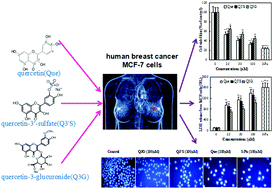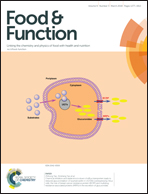Different antitumor effects of quercetin, quercetin-3′-sulfate and quercetin-3-glucuronide in human breast cancer MCF-7 cells
Abstract
This study was designed to investigate the tumor-inhibitory effects of quercetin (Que) and its water-soluble metabolites, quercetin-3′-sulfate (Q3′S) and quercetin-3-glucuronide (Q3G), as well as to make the molecular mechanism and structure–antitumor relationship clear. It was found that Que, Q3′S, and Q3G could inhibit the growth of human breast cancer MCF-7 cells in a dose-dependent manner, with the IC50 values of 23.1, 27.6, and 73.2 μM, respectively, and their anticancer effect was ranked as Que > Q3′S > Q3G. Furthermore, flow cytometric assay revealed that Que, Q3′S, and Q3G mediated the cell-cycle arrest principally at the S phase and decreased the number of G0/G1 and G2/M after a 48 h treatment with human breast MCF-7 cells. Moreover, it was found that 70.8%, 58.2%, and 48.0% of MCF-7 cancer cells entered the early phase of apoptosis when treated with 100 μM Que, Q3′S, and Q3G for 48 h, respectively. In addition, induction of apoptosis by Que, Q3′S, and Q3G was accompanied by marginal generation of intracellular reactive oxygen species (ROS) in the MCF-7 cancer cells. Overall, these results demonstrate that Que, Q3′S, and Q3G possess strong antitumor effects through induction of an ROS-dependent apoptosis pathway in MCF-7 cells.



 Please wait while we load your content...
Please wait while we load your content...